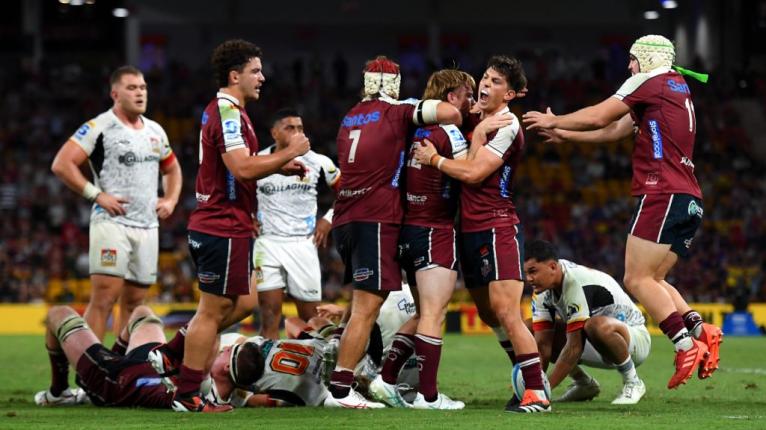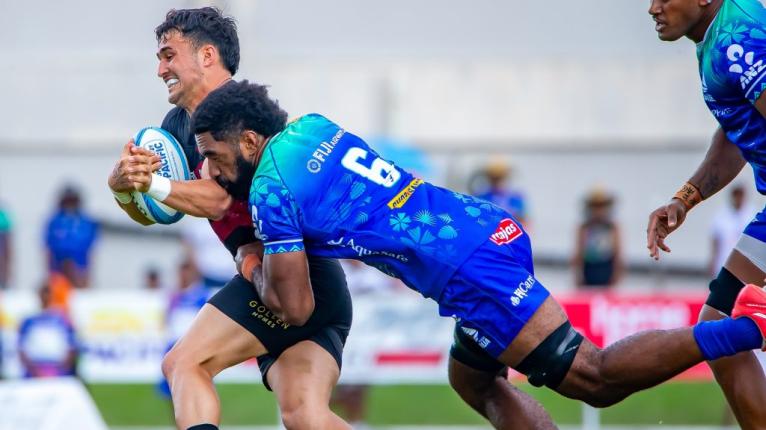It was typically schizophrenic weekend for the tournament which now rejoices in the name Super Rugby Pacific. The world has indeed turned on its head: the competition’s most successful franchise, the Crusaders, fell to a third consecutive defeat by the Fijian Drua in Lautoka and now sit bottom of the table with one solitary bonus point, alongside perennial cellar-dwellers the Western Force.
The Canterbury outfit have lost so many leading lights – principal among them new Ireland prop Oli Jager and All Blacks centurion Sam Whitelock up front; navigator-in-chief Richie Mo’unga, wing/centre Leicester Fainga’anuku and Jack Goodhue behind – it has lost its way entirely, at least for the time being.
Then there is Scott Robertson, who left to coach the national side, taking defence coach Scott Hansen with him. A top-shelf trifecta of championship-winning coaches [including forwards coach Jase Ryan] has gone missing over two seasons, and even the Crusaders’ fabled continuity has been stretched to cover the gaps in IP. The replacements the Crusaders have trawled on the playing front, from countries as far afield as Wales, are not of the same quality as the men who departed, except maybe for Levi Aumua in the centres.

The ranks are thinning everywhere. A mere 400 people crowded into the FMG stadium in Hamilton on Friday evening to watch Melbourne Rebels overcome Moana Pasifika 29-23. They are the two clubs for whom Rugby Australia is alleged to have proposed a secret merger, as the Rebels are wound down with over $22m AUD of debt.
True to its name, the Melbourne franchise will not be disappearing without a fight. It will be raging against the dying of the light in Victorian professional rugby, having launched a legal suit against the directors of RA and its president, ex-Wallaby World Cup winner Joe Roff.
It is likely the lawyers acting on Melbourne’s behalf will be looking to recover $6m AUD in lost funding and a further $2m AUD to cover the wages of Rebels players away on Wallabies duty. If they are successful, there is no reason why the other four Australian franchises could not follow suit, turning Australia’s sunny prospect of a cash windfall from two World Cups and a British and Irish Lions Tour over the next five years into a fiscal ash-cloud.
The pictures circulating on social media after the game in Hamilton implied a tournament dying on its feet.
At the same time, there have been some positive signs the balance of power between Australian and New Zealand provincial rugby, which has been so lopsided in favour of the Kiwis over the past decade, is beginning to shift on its axis. And not a moment too soon.

After three rounds, the New Zealand franchises lead by four wins to two, and the side very much at the sharp end of the resurgence in Australian fortunes is the Queensland Reds. The raw stats already hint at an Aussie side which can compete with the best from across the Tasman.
Queensland are one of only three teams participating in a ball-in-play average of over 37 minutes per game [the others are the Hurricanes and the Chiefs] with over 19 minutes of active time-in-possession [second behind the Blues]. The Reds are in the top three for tries [14] and points [98] scored, with a generous six tries coming deeper in the phase count, after third phase.
Their set-pieces are solid, with a class-leading 90% return on own-ball lineout and 100% of own-ball scrums. At the all-important breakdown, they are one of only two sides to build an average of over 100 rucks per game [the other is the Blues], and one of three to achieve a ratio of over 60% LQB [along with the Drua and the Blues]. At the end of a titanic tussle with the Chiefs in the last round, they defended for 23 phases in their own red zone before winning turnover, and the spoils of victory with it.
Over the last two rounds, the Reds have played the two best teams in the competition – the Chiefs and the Hurricanes – on even terms, losing in extra time to the Canes 33-38 in round two, but overcoming the Chiefs 25-19 at the Suncorp on Saturday.
The Chiefs head honcho Clayton MacMillan could sense the transformation engineered by new man Les Kiss immediately, when he said after the game: “Where the Reds shone was around their effort. It struck me in the pre-season and the first few games that they have got something going right in their environment.
“People are prepared to get off the ground and scramble for each other, and make it hard for others to earn points. [They are] positive signs, [of] the sort we have seen in our [own] group over the past few seasons.”
The victory over the Chiefs was only Queensland’s third in the last 20 attempts against opposition from the Shaky Isles. The tide is turning, and it came as no great surprise to Kiss himself.
“We are not surprised, put it that way. But that is titanic in a way, to hold out the Chiefs. It was probably fitting it went down to the last minute.
“The boys were gutted [to lose to a ‘golden point’ by the Hurricanes] but they did not lose themselves down a cul-de-sac of gloom. They just said, ‘What can we focus on next?’”
The stats indicate Kiss is building a team with a sound structure at set-piece, courtesy of forwards specialist Zane Hilton, but also one capable of playing at sustained speed, with the right ingredients for successful attack. The high number of rucks built, with a similarly ratio of lightning-quick ball delivered from them, is a template Joe Schmidt will be keen to develop at national level later in the year.
Kiss teaches a quick reload into attacking shapes which vary depending on the position on the field.

Playing out of their own last third, the Reds are in 2-3-3, with two complete pods of forwards and a backline receiver behind each. Suli Vunivalu is still manning the right edge to keep the Chiefs honest on defence. They cannot cheat towards the backfield expecting the kick, for as long as ‘the black pearl’ is loitering with intent on the right sideline.
Further upfield, Queensland will begin to open the defence of the outside channels by breaking up their second pod of forwards.

In this instance, the second pod of three has split into a “two” and “one” [#7 Fraser McReight] with the young open-side able to either join his mates inside or play with the far-side wing.
How does it all work in ‘live’ practice? Here is the Reds’ second try of the first half.
In the first clip, the ball travels through the second pod of forwards led by Seru Uru in midfield, with number eight Harry Wilson and seven McReight as the two loose ‘jokers’ beyond it. After a quick ruck delivery over number 11 Mac Grealy [in the white hat], it is Wilson who makes that extra effort observed by Clayton MacMillan, swinging from one side of the ruck to the other to make the extra man on the next wave of attack.

The Reds ‘key second-half try was also the product of precise structure liberating the skills contained in individuals within the XV as a whole.
In the first clip, the ball goes straight through the ‘tunnel’ of the first pod of forwards to Harry McLaughlin-Phillips, and on through the pair of Wilson and Zane Nongorr outside him. The Queensland number eight is empowered to play the situation in front of him and tip on to Nongorr, who is opposed by a Chiefs back. The mismatch means instant gain-line, and more LQB on the next phase.
When the Reds kick through, they do so on their own terms, with five chasers – including McReight as the joker outside – outnumbering two Chiefs in the backfield. Any odd bounces in the oval, and the odds are in favour of the Maroons. The 3-2-1 formation clarifies roles and allows the Reds players to ‘react without thinking’ to what is in front of them.
That structural clarity has also helped develop those players who have always had the talent, but lacked the tactical direction to make it count, such as Vunivalu. Like Grealy, Vunivalu is now required to move infield to make plays.
He is also being asked to become a true ‘triple threat’ attacker, running and then kicking for his opposite wing in the first example, and distributing off the threat of the run in the second. It will give him that extra shove in the back to become bona fide Wallaby under Schmidt.
The splits in Super Rugby Pacific are growing wider, but at the same time some new green shoots are appearing in the cracks. The Crusaders have been temporarily supplanted as New Zealand’s number one team, and the thinning of the coaching and playing ranks points up a concern for professional depth throughout the country.
The newer franchises still struggle to attract a broad base of support within their host unions, or even from the governing body itself in the case of the Melbourne Rebels. There remains a lot of residual rancour surrounding the actions of RA in both Victoria and Western Australia, and it will not be resolved anytime soon.
On the positive side, there are signs the lost power balance between Australia and New Zealand may be restored at least partially. New Zealand needs a strong Australia to recreate a genuinely competitive provincial environment and a more marketable product in the southern hemisphere, and the Reds are leading the way. If there is to be a new dawn in Super Rugby, it may well be maroon in colour.



Comments
Join free and tell us what you really think!
Sign up for free